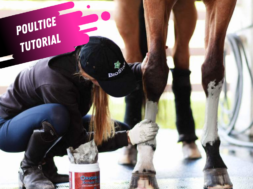What Is A Poultice?
Poultice has been in use by people for thousands of years, since at least Egyptian times.
“It’s part of the regular daily routine for every horse that is exercised beyond a light workout,” said Craig Schmersal, winner of a gold medal in the 2002 World Equestrian Games, to HorseChannel.com.
Poultice’s second function is to drain the fluid from abscesses on the underside of the hoof. An abscess forms when harmful bacteria invades the sensitive areas of the foot and causes pain. The affected area has purulent material, much like the pus on a pimple, that needs to be removed so the foot can heal. An abscess can burst on its own, or its source within the hoof can be vented for drainage by a veterinarian. Poultice can then be applied to suck the infection from the wound and prevent further contamination.
Leg application
Equine skin is eight to 10 times more sensitive than human skin, which means they feel the effects of inflammation and injuries like abscesses more than you might.
Things you will need:
Poultice clay
A bucket of water
Poultice paper, newspaper or another thin paper, or plastic bag of any sort
Bandages or cotton sheet
Bandage wraps
Tape, safety pins or another type of fastener
Gloves, if desired
It is recommended that these items be kept within arm’s reach while working on the foot. Take the following steps (as shown in a video from Finish Line):
Preparation
Tie the horse’s tail when working on rear legs so it does not get in the way. Be sure not to sit too far away from the horse’s rear. If it decides to kick, the closer you are to its knee, the less exposed you are to accidental injury. It may also help to have another person present during the application process to keep the horse calm.
Clean the legs thoroughly with castile soap or other non-medicated cleanser.
Using gloves or bare hands, apply poultice evenly to affected area in a layer 1/8 to 1/4 inch thick. Coat the leg up the bottom of the knee and the top of the hoof. It is not recommended that the material be applied to the heels or behind the knees.
Application
Wash poultice from the hands in bucket of water, or remove gloves.
Prepare manufactured or homemade poultice paper. If making your own, use water to moisten the thin sheets of paper or plastic you collected. Manufactured poultice paper should already be wet. Wrap this layer of material fully around the poultice sections. Be careful to avoid too much overlap or too many wrinkles.
Apply the bandage. Do not wrap the bandage too tightly around the leg. This may cause injury to tendons and possible circulation problems. However, bandages that are too loose may unwrap and tangle in the horse’s legs causing it to panic and risk injury.
Secure bandage with bandage wraps. Start wrap in the center of the bone then move downward to the hoof. Come back up to the middle then wrap the top of the leg portion before ending in the wrap’s point of origin. Exert caution applying tightness. Fasten wraps with tape, safety pins or another type of adherent.
Leave the bandage on overnight.
As the poultice removes heat and fluid from the leg, the clay will dry into a chalky crust. If the clay is still wet the next day, there was no excessive heat or liquid in the leg (which is ultimately a good thing.)
Removing The Poultice
To remove dry poultice, take the following steps:
Use grooming gloves or strong brush to scrape away any stable shavings or dirt from the outermost portion of the wrapping, especially if the wrapping will be reused.
Remove bandages and wraps to expose poultice leg.
Use grooming gloves or brush to thoroughly rub clay away using a downward motion. Utilizing a single finger at a time will allow you to get between individual tendons for more precise cleaning.
Rinse off with cold water.










